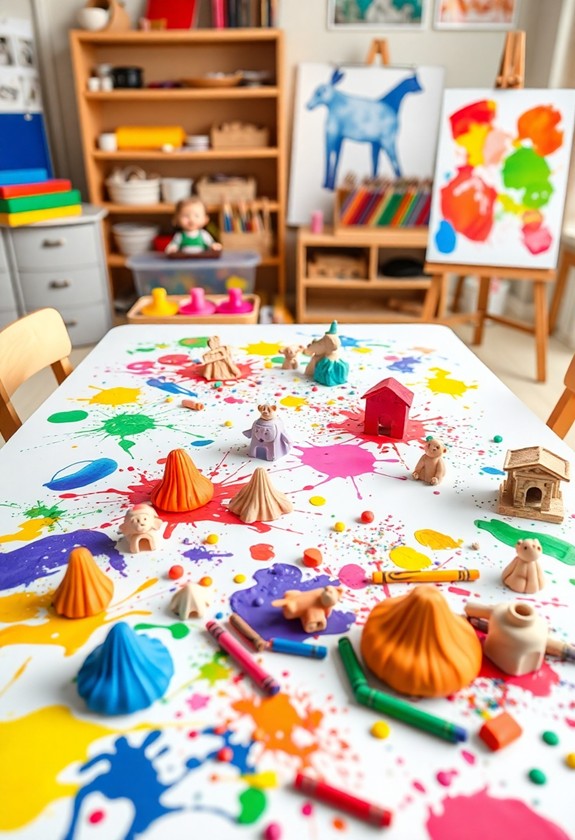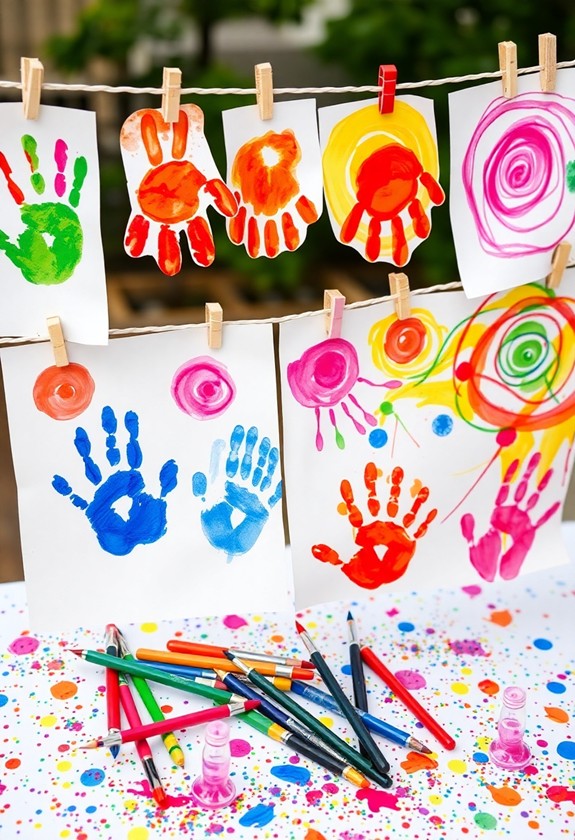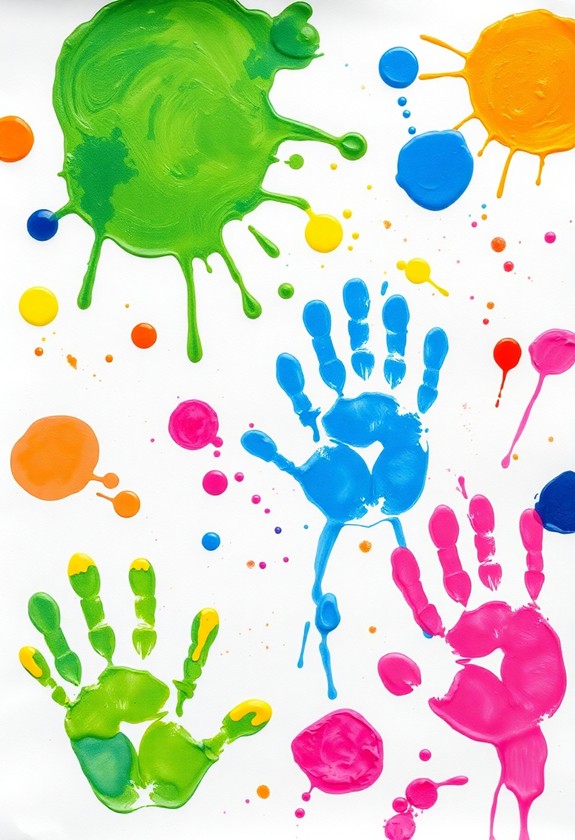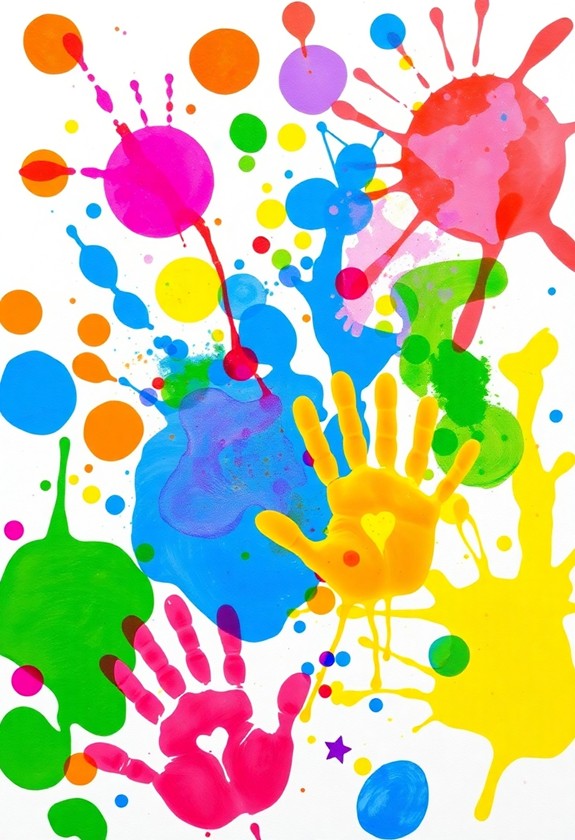Art therapy isn't just fun and games — it's a powerhouse for your child's development! It improves emotional expression, letting kids release their feelings through color and shape. Your little artist's fine motor skills will skyrocket as they paint, draw, and sculpt. Plus, their brain gets a serious workout, boosting cognitive skills and problem-solving abilities. Social butterflies emerge as kids share and discuss their masterpieces. And talk about a confidence boost! Creating art strengthens self-esteem and releases wild imagination. But wait, there's more to this colorful story of growth and creativity! Curious about the full picture?
Creative Highlights
- Art therapy enhances emotional expression, providing a safe space for children to explore complex feelings non-verbally.
- Group art sessions foster social interaction, improving communication skills and encouraging collaboration among peers.
- Engaging in artistic activities strengthens self-esteem by providing a judgment-free environment for creativity and self-expression.
- Art therapy boosts cognitive development, promoting critical thinking, problem-solving, and spatial awareness skills.
- Creating art improves fine motor skills through activities like painting, drawing, and sculpting, enhancing hand-eye coordination and dexterity.
Enhances Emotional Expression
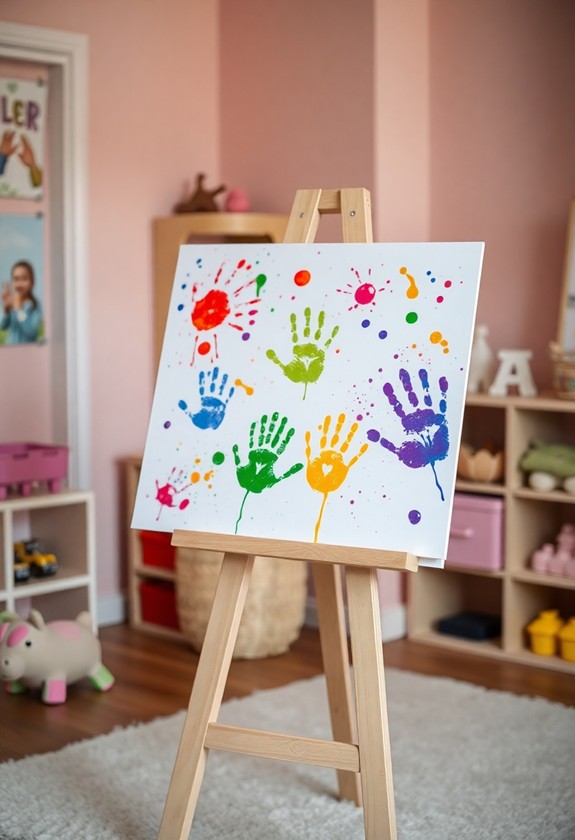
Children often struggle to put their feelings into words. That's where art therapy comes in! It's like a magical key that unlocks their emotions and helps them express themselves in amazing ways. When kids engage with art projects, they're actually developing essential skills without even realizing it. Art therapy not only boosts creativity but also promotes fine motor skills and hand-eye coordination, contributing to overall child development.
How does art therapy boost emotional expression? It's simple! Through drawing, painting, or sculpting, children can show what's in their hearts and minds. They might use bold colors to express anger or soft pastels for calm feelings. It's like they're painting their emotions onto paper!
Art therapy gives kids a safe space to investigate complex emotions. They can work through fears, joys, and worries with a crayon or paintbrush in hand. It's a form of communication that doesn't need words, which is perfect for little ones still learning to verbalize their feelings.
Plus, it's fun! Who doesn't love getting messy with paint or creating a colorful masterpiece? As they create, they're actually building emotional intelligence and self-awareness. It's a win-win situation that'll have them beaming with pride and understanding themselves better. How's that for a picture-perfect way to grow?
Improves Fine Motor Skills
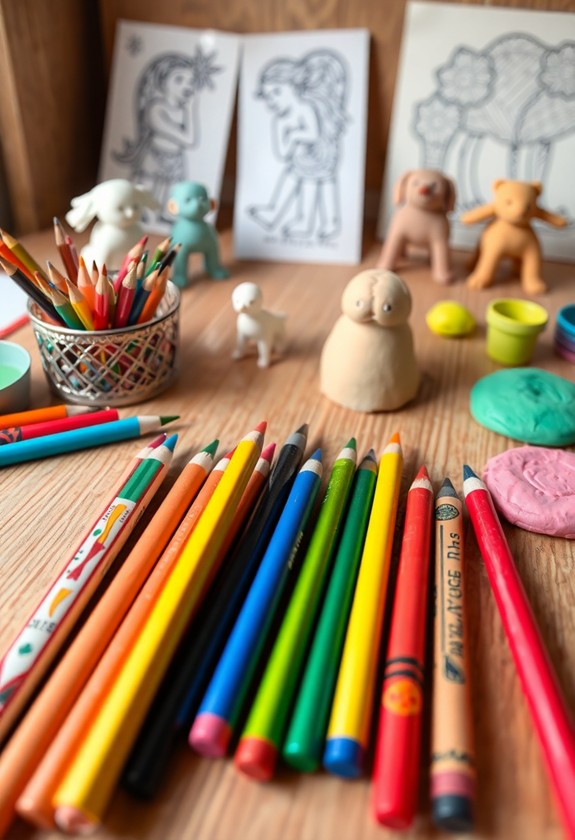
Art therapy sessions serve as a playground for fine motor skill development. When you're holding a paintbrush, molding clay, or cutting paper, you're doing so much more than creating art – you're building hand strength and dexterity! These activities require precise movements of your fingers, hands, and wrists, which are essential for everyday tasks. Craft kits can provide structured activities that improve these skills during promoting creativity and self-expression. They offer a variety of tools and materials that challenge different aspects of fine motor control.
As you engage in art projects, you're unknowingly practicing skills that'll help you write, tie shoelaces, and even use a computer keyboard. It's like a workout for your hands, but way more fun! And the best part? You're improving these skills without even realizing it.
Here's how art therapy boosts fine motor skills:
- Painting: Helps with grip strength and hand-eye coordination
- Drawing: Improves finger control and precision
- Sculpting: Enhances hand muscles and finger dexterity
- Cutting and pasting: Develops bilateral coordination
Boosts Cognitive Development
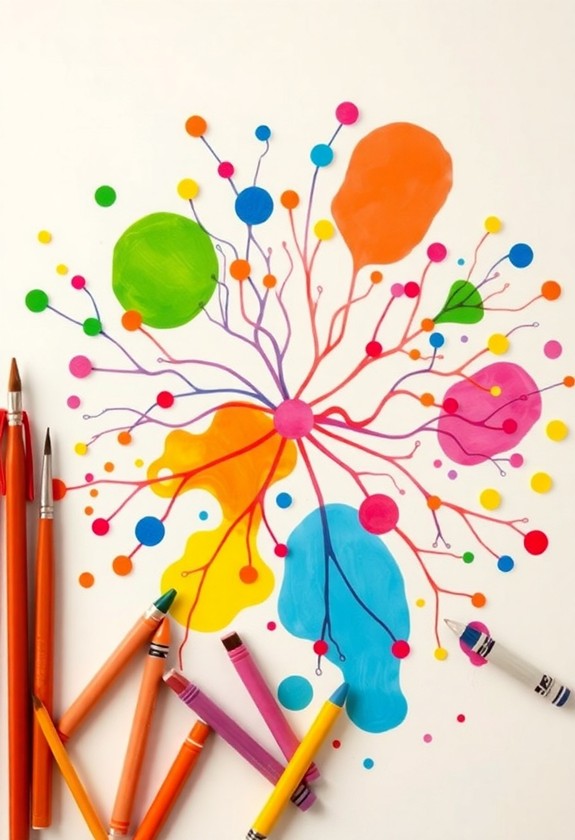
Every brushstroke and creative decision in art therapy can spark cognitive growth. When your child engages in artistic activities, their brain lights up like a fireworks display! They're not just making pretty pictures; they're developing essential thinking skills that'll serve them well throughout life. Multi-sensory experiences through art therapy aid in memory retention and information processing, fundamental for early childhood development. Regular creative engagement nurtures neural connections critical for language and spatial awareness.
Art therapy boosts your child's cognitive development in amazing ways:
- Problem-solving: They'll learn to tackle challenges creatively, figuring out how to bring their ideas to life!
- Decision-making: Choosing colors, materials, and techniques helps sharpen their decision-making muscles.
- Abstract thinking: Art encourages them to think outside the box and see things from new perspectives.
- Memory improvement: Remembering techniques and recreating images strengthens their memory power.
But wait, there's more! Art therapy additionally improves focus and attention span. Your little Picasso will learn to concentrate on tasks for longer periods. And don't forget about spatial awareness! As they arrange elements on paper, they're developing a keen sense of space and proportion.
Fosters Social Interaction
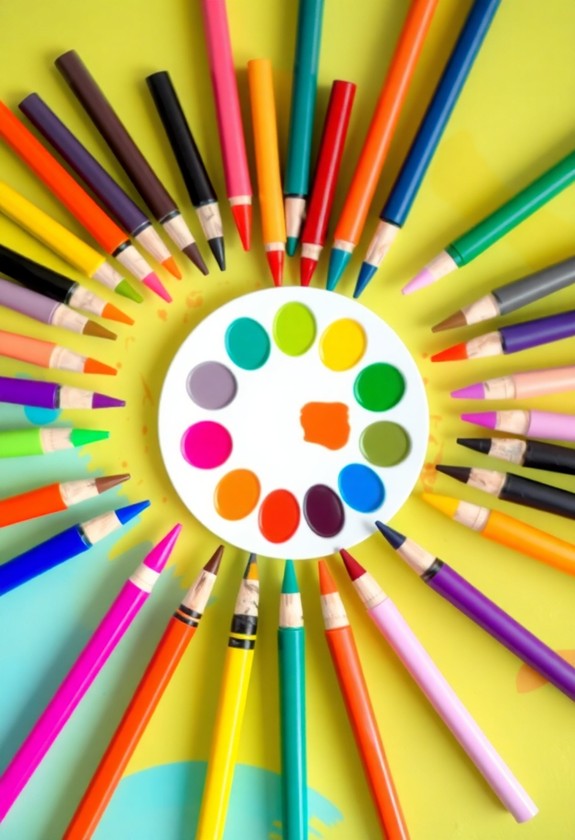
Even though cognitive growth is impressive, art therapy's social benefits are similarly remarkable. When kids engage in art therapy, they're not just creating masterpieces – they're building bridges to others! Group art sessions are like social playgrounds where children learn to share, take turns, and collaborate. It's amazing to watch them work together on a mural or sculpture, trading ideas and compliments like little artists at a gallery opening! Collaborative crafting efforts can improve teamwork and communication skills, nurturing a sense of community in play dates, classrooms, and family activities.
Art therapy additionally helps children express their feelings and understand others' emotions. They'll learn to "read" facial expressions in portraits and body language in sculptures. This emotional literacy is like a superpower for making friends and steering through social situations!
Communication skills get a colorful boost too! Kids learn to describe their artwork, listen to others, and give constructive feedback. It's like they're painting with words in addition to brushes! And don't forget about confidence building. When children proudly display their creations, they're demonstrating their growing self-esteem. Art therapy truly helps kids become social butterflies, ready to spread their wings in the world of friendships and teamwork!
Cultivates Problem-Solving Abilities
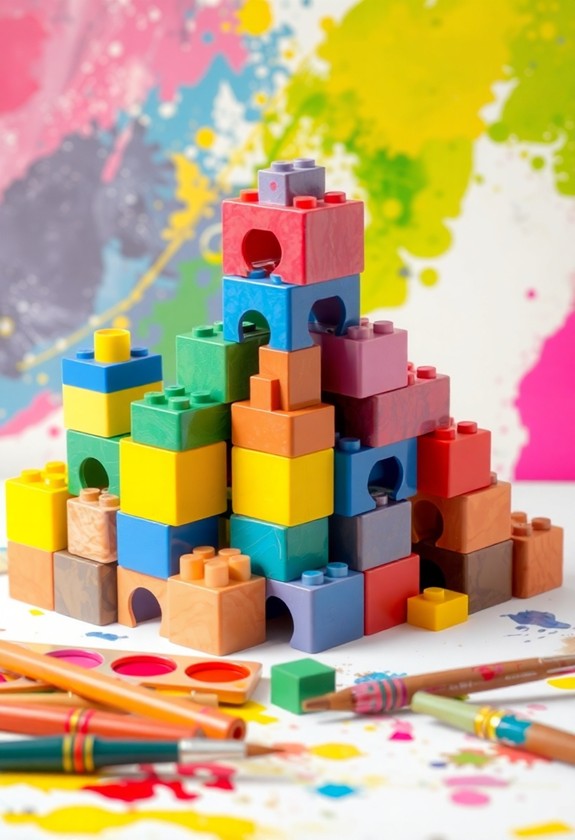
While creating art may seem like pure fun, it's actually a powerful tool for developing problem-solving skills. When your child engages in art therapy, they're constantly making decisions and overcoming challenges. It's like a playground for their brain! Art encourages self-expression and cognitive development, promoting critical thinking skills that extend beyond the canvas. Using thorough art supply kits can provide a wide range of materials for diverse problem-solving opportunities.
Here's how art therapy cultivates problem-solving abilities:
- Color conundrums: Choosing the right colors and mixing them to get the perfect shade is a mini-puzzle in itself!
- Shape shenanigans: Figuring out how to represent objects or ideas using different shapes helps build spatial reasoning.
- Material mysteries: Experimenting with various art supplies teaches adaptability and resourcefulness.
- Composition quests: Deciding where to place elements on a page develops planning and organization skills.
But wait, there's more! Art therapy encourages your child to think outside the box and find creative solutions. When they're faced with a blank canvas, they must decide what to create and how to bring their vision to life. This process of turning ideas into reality is a fantastic workout for their problem-solving muscles. And the best part? They're having so much fun, they don't even realize they're learning!
Strengthens Self-Esteem
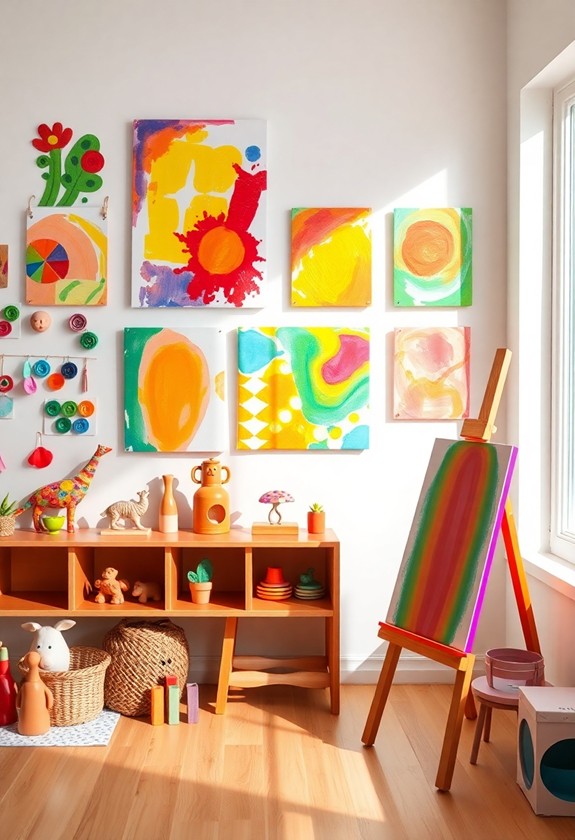
As children solve artistic challenges, they simultaneously build another crucial skill: self-esteem. Art therapy provides a safe space for kids to express themselves freely, without fear of judgment. When they create something unique, they feel a sense of accomplishment that boosts their confidence! Toddler crafts are particularly effective in unlocking creativity and encouraging brain development, making them an excellent choice for young children.
You'll notice your child beaming with pride as they show off their masterpieces. This isn't just about making pretty pictures – it's about cultivating a positive self-image. Through art, kids learn to value their own ideas and abilities. They're not just drawing; they're drawing out their inner strength!
Here's how art therapy strengthens self-esteem:
- It encourages self-expression
- It celebrates individuality
- It provides a sense of achievement
- It helps children see their own progress
But wait, there's more! Art therapy equally teaches kids that it's okay to make mistakes. Oops, you spilled some paint? No problem! Turn that blob into a beautiful butterfly. This resilience carries over into other areas of life, helping children face challenges with confidence. So, grab those crayons and let the self-esteem-boosting begin!
Encourages Creativity and Imagination
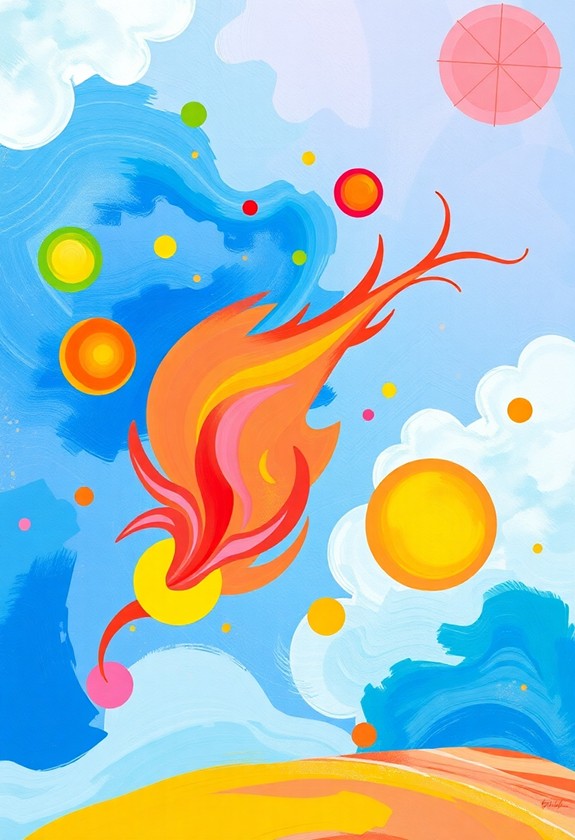
Once children step into the world of art therapy, their creativity and imagination take flight. It's like opening a magical door to a universe of endless possibilities! Through art, kids can express ideas and emotions they might not have words for yet. They'll mix colors, shapes, and textures to create unique masterpieces that reflect their inner worlds.
Art therapy provides a safe space for children to investigate and experiment. Here's what happens when they plunge into it:
- They'll invent new characters and stories
- They'll problem-solve by figuring out how to bring their ideas to life
- They'll learn to think outside the box and accept unconventional ideas
- They'll uncover new ways to communicate their thoughts and feelings
Unleash the power of imagination! Every scribble, every brushstroke is a step towards creative freedom. You'll be amazed at how quickly children's minds expand when given the chance to create without limits. And the best part? There are no wrong answers in art! This freedom allows kids to take risks, make mistakes, and learn from them – all during the fun. So grab those crayons and let the creativity flow!
Curious Little Questions
What Age Is Appropriate to Start Art Therapy for Children?
You'll be thrilled to know that art therapy can start at any age! Even toddlers can benefit from this creative approach. But don't worry if your child is older – it's never too late to begin! Most experts agree that around 4 or 5 is a great time to start, as kids are developing their communication skills. Remember, every child is unique, so trust your instincts! If you think your little Picasso could use some extra support, go ahead and give it a try!
How Often Should Children Participate in Art Therapy Sessions?
Like a painter adding layers to a masterpiece, your child's art therapy expedition should be consistent! The frequency of sessions depends on their needs, but typically, once a week is great. Some kids benefit from twice-weekly sessions, whereas others do well with bi-weekly visits. It's all about finding the right rhythm! Remember, consistency is key. Talk to the therapist, they'll help you decide what's best. And don't forget, art at home can be therapeutic too!
Can Art Therapy Help Children With Learning Disabilities?
Art therapy can be a game-changer for kids with learning disabilities. It's like a secret superpower that helps them express themselves and learn in new, exciting ways! You'll be amazed at how it can boost their confidence, improve focus, and even elevate problem-solving skills. Plus, it's so much fun! Whether it's painting, sculpting, or drawing, art therapy gives these awesome kids a chance to shine and overcome challenges. It's truly a colorful path to success!
Are There Any Risks or Side Effects of Art Therapy?
You'll be happy to know that art therapy is typically safe and fun. There aren't many risks, but here are a few things to watch out for:
- Some materials might cause allergies – oops!
- Kids might get messy – welcome the chaos!
- Emotions can surface – that's okay, it's part of healing!
What Qualifications Should an Art Therapist Working With Children Have?
You'll want an art therapist who's got the right stuff! Look for someone with a master's degree in art therapy and a license to practice. They should be certified by the Art Therapy Credentials Board too. Experience working with kids is a must! Make certain they've got special training in child development and psychology. And don't forget, a great art therapist should be creative, patient, and able to connect with children easily. It's like finding a superhero with a paintbrush!

